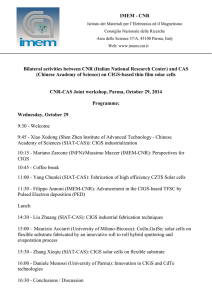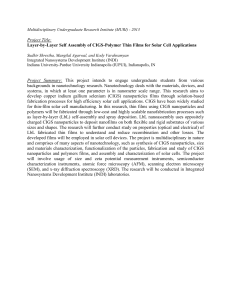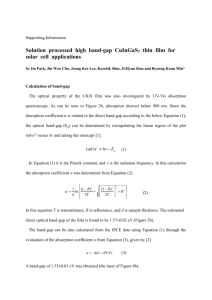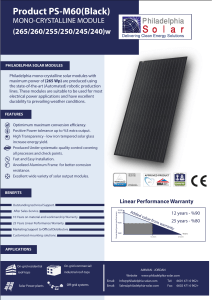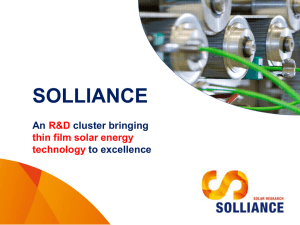High-Efficiency CIGS Thin
advertisement
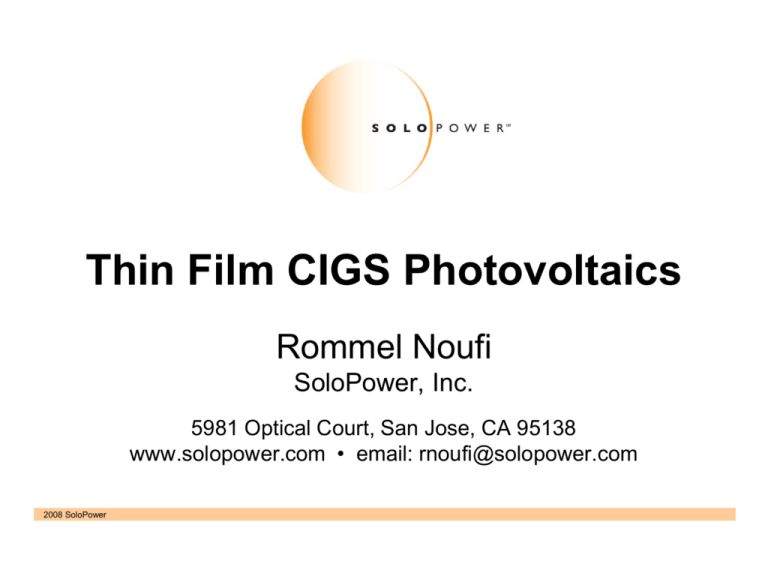
Thin Film CIGS Photovoltaics Rommel Noufi SoloPower, Inc. 5981 Optical Court, San Jose, CA 95138 www.solopower.com • email: rnoufi@solopower.com 2008 SoloPower Acknowledgements: Bulent Basol SoloPower, Inc., California Robert Birkmire Institute of Energy Conversion, Delaware Bolko von Roedern, Michael Kempe, and Joel Del Cueto National Renewable Energy Laboratory, Colorado 2008 SoloPower 2 Outline Status of the Technology – Laboratory cells – Modules Challenges Ahead 2008 SoloPower 3 Status of PV • 3700 MW produced world wide • 266 MW produced in the US • Thin Film Market Share: 10% world wide, 65% in the US Source: PV News, Photon International, Navigant Consultants 2008 SoloPower 4 Status of Thin Film PV • Currently, FIRST SOLAR [ CdTe ] is the largest Thin Film manufacturing company in the US - 277 MW in 2007 - 910 MW expected in 2009 • Demonstrated the viability of Thin Film PV - High Throughput - Large Scale - Low Cost per Watt Source: First Solar.com 2008 SoloPower 5 PVNews Reported US Production thru 2007 Source: PVNews 2008 SoloPower 6 CIS PV Companies Production of CIGS modules has also been demonstrated by: Würth Solar, Showa Shell, Honda, and Global Solar Energy (<20 MW manufactured) Ascent, CO DayStar Technologies, NY/CA Energy Photovoltaics, NJ Global Solar Energy, AZ HelioVolt, TX ISET, CA MiaSole, CA NanoSolar Inc., CA SoloPower, CA Solyndra, CA Stion, CA 2008 SoloPower Aleo Solar, Germany AVANCIS, Germany CIS Solartechnik, Germany CISEL, France Filsom, Switzerland Honda, Japan Johanna Solar Tech, Germany Odersun, Germany PVflex, Germany Scheuten Solar, Holland Showa Shell, Japan Solarion, Germany Solibro, Sweden SULFURCELL, Germany Würth Solar, Germany 7 CIGS Device Structure ZnO, ITO 2500 Å CdS 700 Å CIGS 1-2.5 µm Mo 0.5-1 µm Glass, Metal Foil, Plastics 2008 SoloPower 8 Best Research-Cell Efficiencies 2008 SoloPower 9 Parameters of High Efficiency CIGS Solar Cells Sample Number Voc (V) Jsc (mA/cm2) Fill factor (%) Efficiency (%) M2992-11 0.690 35.55 81.2 19.9 (World Record) S2212-B1-4 S2232B1-3 S2232B1-2 S2229A1-3 S2229A1-5 S2229B1-2 S2213-A1-3 0.704 0.713 0.717 0.720 0.724 0.731 0.740 34.33 33.38 33.58 32.86 32.68 31.84 31.72 79.48 79.54 79.41 80.27 80.37 80.33 78.47 19.2 18.9 19.1 19.0 19.0 18.7 18.4 Tolerance to wide range of molecularity Cu/(In+Ga) 0.95 to 0.82 Ga/(In+Ga) 0.26 to 0.31 Yields device efficiency of 17.5% to 19.5% 2008 SoloPower 10 “Champion” Modules Company Device Aperture Area (cm2) Efficiency* Power (W) Würth Solar CIGS 6500 13.0 84.6 Shell Solar GmbH CIGSS 4938 13.1 64.8 Showa Shell CIGS 3600 12.8 44.15 Shell Solar CIGSS 7376 11.7 86.1* Global Solar CIGS 8390 10.2 88.9* First Solar CdTe 6623 10.2 67.5* *Third party confirmed 2008 SoloPower 11 Optical Band-Gap/Composition/Efficiency theoretical High efficiency range Absorber band gap (eV) 2008 SoloPower 12 Closing the Gap between Laboratory Cells and Modules Primary Focus: Utilizing Lab Technology base to translate results to manufacturing 2008 SoloPower 13 CIGS Modules are Fabricated On: I. Soda lime glass as the substrate; cells are monolithically integrated using laser/mechanical scribing. Courtesy of Dale Tarrant, Shell Solar Monolithic integration of TF solar cells can lead to significant manufacturing cost reduction; e.g., fewer processing steps, easier automation, lower consumption of materials. 2008 SoloPower 14 CIGS Modules are Fabricated On: (cont.) The number of steps needed to make thin film modules are roughly half of that needed for Si modules. This is a significant advantage. CIGS Modules Process Sequence Substrate preparation Base Electrode First Scribe Absorber Third Scribe Top Electrode Second Scribe Junction Layer External Contacts 2008 SoloPower Encapsulation 15 CIGS Modules are Fabricated On: (cont.) II. Metallic web using roll-to-roll deposition; individual cells are cut from the web; assembled into modules. III. Plastic web using roll-to-roll deposition; monolithic integration of cells. 2008 SoloPower 16 Challenges 2008 SoloPower 17 Long-Term Stability (Durability) • Improved module package allowed CIGS to pass damp heat test (measured at 85°C/85% relative humidity). • CIGS modules have shown long-term stability. However, performance degradation has also been observed. • CIGS devices are sensitive to water vapor; e.g., change in properties of ZnO. - Thin Film Barrier to Water Vapor - New encapsulants and less aggressive application process • Stability of thin film modules are acceptable if the right encapsulation process is used. • Need for better understanding degradation mechanisms at the prototype module level. 2008 SoloPower 18 Processing Improvements: I. Uniform Deposition over large area: (a) significant for monolithic integration (b) somewhat relaxed for modules made from individual cells II. Process speed and yield: some fabrication approaches have advantage over others III. Controls and diagnostics based on material properties and film growth: benefits throughput and yield, reliability and reproducibility of the process, and higher performance 2008 SoloPower 19 Processing Improvements: (cont.) IV. Approaches to the thin film CIGS Deposition 1. Multi-source evaporation of the elements - Produces the highest efficiency - Requires high source temperatures, e.g., Cu source operates at 1400°-1600°C - Inherent non-uniformity in in-line processing - Fast growth rates my become diffusion limited - Complexity of the hardware with controls and diagnostic - One of a kind hardware design and construction - Expensive - Throughput, and material utilization need improvement 2008 SoloPower 20 Processing Improvements: (cont.) IV. Approaches to the thin film CIGS Deposition (cont.) 2. Reaction of precursors in Se and/or S (Selenization) to form thin film CIGS: two stage process - Variety of materials delivery approaches: (a) sputtering of the elements (b) electroplating of metals or binaries (c) Printing of metal (or binaries) particles on substrate - Reaction time to form high quality CIGS films is limited by reaction/diffusion - Modules on glass are processed in batch mode in order to deal with long reaction time - Flexible roll-to-roll requires good control of Se vapor and reaction speed - Ga concentration thru the film is inhomogeneous limiting performance 2008 SoloPower 21 Processing Improvements: (cont.) V. Reduction of the thickness of the CIGS film - Reduces manufacturing costs: higher throughput and less materials usage - More sensitive to yield, Thin Cells Summary e.g. threshold thickness nonuniformity, pin-holes - Challenge is to reduce thickness and maintain performance 2008 SoloPower 22 0.4 µm cell - Optical Absorption 80 %T, A, QE 60 T QE 40 20 R of Cell 0 400 2008 SoloPower 600 800 1000 Wavelength (nm) 1200 1400nm Toward Low Cost • Module performance is a significant determining factor of cost • Cell processing affects performance • The benefits of each process and how it is handled in manufacturing need to be assessed • To date, relatively high cost methods adapted for manufacturing 2008 SoloPower 24 SoloPower Advances • SoloPower has developed a low cost electrodeposition process to manufacture CIGS solar cells and modules V electrolyte anode • A conversion efficiency approaching 14% has been confirmed at NREL • Modules have been manufactured demonstrating process flow 2008 SoloPower 25 The Electrodeposition Process • Hardware is low cost • Can be high throughput once the hardware is tuned to the specifics of the process • Near 100% material utilization • Pre-formed expensive materials are not required, e.g. sputtering targets, nano-particles • Crystallographically oriented CIGS films with good morphology and density have been demonstrated • Thickness and composition control of the deposited films are integral part of the process • Readily scalable 2008 SoloPower 26 C2318 2008 SoloPower SoloPower Confidential Future Commercial Module Performance Based on today’s champion cell results and a module/cell-ratio of 80% Future commercial performance Relative Performance (s.p. Si =1) Silicon (non-stand) 19.8% 1.18 0.85 (competitive) Silicon (standard) 17.0% 1.00 1.00 (reference) CIS 15.9% 0.94 0.53 (highly competitive) CdTe 13.2% 0.78 0.64 (highly competitive) a-Si (1-j) 8.0% 0.47 1.06 (about the same) a-Si (3-j) (or a-Si/nc-Si) 9.7% 0.57 0.88 (competitive) Technology Relative-cost/relativeperformance (50% thin film cost advantage) Source: Bolko Von Roedern, PVSC 2008, IEEE May 12,2008, San Diego 2008 SoloPower 28 Best Production-Line PV Module Efficiency Values Ranked Module Efficiency (%) 19.3 (non-stan) 17.4 (non-stan) 14.4 (non-stan) 14.2 (multi) 14.1 (mono) 13.9 (mono) 13.8 (multi) 13.7 (multi) 13.4 (mono) 13.4 (mono) 13.4 (multi) 13.1 (ribbon) 11.3 (CIGS) Same module with lowe st power rating Descriptio n of best module SunPower 315 (SunPower rear-point contacted cells, mono-Si) Tcoeff = -0.38 %/C, VOC/cell = 673 mV Sanyo HIP -205BAE (single crysta l CZ Si, HIT (Tcoeff = -0.30 %/C), VOC/cell = 717 mV Advent Solar Advent 240 (emitter wrap thru multi-Si) Tcoeff= -0.52%/C, VOC/cell = 610 mV Kyocera KC200GHT-2 (cast multi-Si diffused cells) Tcoeff.(only given for Voc, -0.123 V/C), VOC/cell = 609 mV Sharp NU-185 (mono-Si, standard) -0.485%/C, VOC/cell = 629 mV BP4175 (mono-Si – standard) Tcoeff= -(0.5±0.05) %/C, VOC/cell = 606 mV BP BP3230 multi-Si standard cells) Tcoeff= -(0.5±0.05) %/C, VOC/cell = 607 mV Sharp ND-224-U1 (multi-Si, diffused) Tcoeff=-0.485%/C , VOC/cell = 610 mV SolarWorld Sunmodule 175/165/155 (mono-Si “Shell”) Tcoeff.: VOC= -0.33V/C, VOC/cell = 617 mV Also as Sharp 216, then 13.3% efficient 25-y ltd warranty Also SW 155, efficiency 11.9% Power-warranty 12/90%, 25/80% SunTech STP 260S-24V/b (mono-Si diffused cells) VOC/cell = 615 mV 25-y ltd warranty Solar World AG SW 225 (multi-Si) Tcoeff.: VOC= -0.33V/C, VOC/cell = 613 mV Evergreen Solar ES 195 (string ribbon Si) Tcoeff= -0.49%/C, VOC/cell = 609 mV Solibro SL1-85 (CIGS) Tcoeff=-0.45%/C Also SunPower 305, efficiency 18.7% Also HIP-180BA E, efficiency 15.3% Also A dvent 210, efficiency 12.6% Only one rating listed, Also Sharp NU-170, efficiency 13.0% Also BP4165, efficiency 13.1% Also BP3210, efficiency 12.6%, 25-y ltd warranty Also SW 200, efficiency 11.9% Also ES-180 efficiency 12.0% Also as SL1-60, then eff. is 8.0% From Manufacturers’ Web Sites Compiled by Bolko von Roedern, September 2008 2008 SoloPower Best Production-Line PV Module Efficiency Values (cont.) Ranked Module Efficiency (%) 11.2 (CIGS) 11.0 (CIS) 10.4 (CdTe) 9.0 (CdTe) 8.5 (a-Si/nc-Si) 8.2% (a-Si/nc-Si) 8.0 (CIGS) 6.3 (a-Si 1-j) 6.3 (a-Si 3-j) 6.3 (a-Si 1-j) 5.9 (a-Si 1-j) 5.9 (a-Si/a-Si) 5.3 (a-Si/a-Si) Same module with lowe st power rating Descriptio n of best module Honda HEM125PA (CIS) WürthSolar WS GOO25 E080 (CIS) Tcoeff.= -0.36 %/C First Solar FS-275 (CdTe) Tcoeff= -0.25 %/C Voc/cell = 773 mV Calyxo CX 65 (CdTe) Tcoeff= -0.25 %/C Sharp NA-901-WP (90-W) (amorphous/nanocrystalline Si tandem) Tcoeff=-0.24%/C Sontor SN2-145 (amorphous/nanocrystalline Si tandem) Tcoeff=-0.40%/C GSE Solar GSE 33060 Tcoeff=-0.5%/C Mitsubishi Heavy MA100 T2 (single j. a-Si, VHF deposition), Tcoeff.= -0.2 %/C Uni-Solar PVL 136 (triple-j. amorphous silicon roofing laminate), Tcoeff = - 0.23%/C Kaneka T-SC(EC)-120 (single-j. a-Si) No Tcoeff. given Ersol Nova-T GOO25 E080 (single-j. a-Si) Tcoeff.= -0.31 %/C Schott Solar ASI-TM86 (same-bandgap double junction a-Si) Tcoeff = - 0.20%/C EPV EPV-42 (same-bandgap double junction a-Si) Tcoeff = - 0.19%/C Also available as 115W, then 10.3% efficient Also WS GOO25 E075, efficiency 10.3% (warranty 20/80%) Also FS-260, efficiency 8.3% (25-y ltd warranty) Also as CX 35 , then eff. is 4.9% Also Sharp NA-801 (80W) Efficiency 7.6% (warranty: 10/90%, 20/80%) Also as SN2-125 , then eff. is 7.0% Only one rating, but +/-15% power spec, 25-y ltd warranty Only one rating (warranty 20/80% warranty) Also as 124 W, eff. 5.7% (20-year ltd warranty) Only one rating (ltd warranty 25/80%) Also available as 70 W, eff. then 4.9% From Manufacturers’ Web Sites Compiled by Bolko von Roedern, September 2008 2008 SoloPower Also ASI TM78, eff 5.4% 20-y ltd warranty Also EPV-40, eff 5.1% (warranty 25/80%) Further Reading Sources “Accelerated UV Test Methods for Encapsulants of Photovoltaic Modules” “Stress Induced Degradation Modes in CIGS Mini-Modules” Michael D. Kempe et al, Proceedings of the 33rd IEEE,PVSC, May 11, 2008, San Diego “Modeling of Rates of Moisture Ingress into Photovoltaic Modules” Michael D. Kempe, Solar Energy Materials & Solar Cells, 90 (2006) 2720–2738 “Stability of CIS/CIGS Modules at the Outdoor Test Facility Over Two Decades” J.A. del Cueto, S. Rummel, B. Kroposki, C. Osterwald, A. Anderberg, Proceedings of the 33rd IEEE,PVSC , May 11, 2008, San Diego “Pathways to Improved Performance and Processing of CdTe & CuInSe2 Based Modules” Robert W. Birkmire, Proceedings of the 33rd IEEE,PVSC, May 11, 2008, San Diego “The Role of Polycrystalline Thin-Film PV Technologies in Competitive PV Module Markets” Bolko von Roedern and Harin S. Ullal, Proceedings of the 33rd IEEE,PVSC , May 11, 2008, San Diego “High Efficiency CdTe and CIGS Thin Film Solar Cells: Highlights and Challenges” Rommel Noufi and Ken Zweibel Proceedings of the 4th WCPEC, May 7, 2006, Hawaii 2008 SoloPower 31 The End 2008 SoloPower 32 2008 SoloPower 33 PV Energy Cost DOE, Solar America Initiative Projections and Goals • Costs are constant 2005 dollars • Residential and commercial are cost to customer Solar Electricity cost • Utility is cost of generation 2008 SoloPower 34 CIGS Manufacturing Requirements for a CIGS absorber film growth technique for high efficiency devices include: For high quality – Stoichiometric control [Cu/(Ga+In), Ga/(Ga+In), S/(S+Se)] – Good microstructure – Bandgap control For low cost – – 2008 SoloPower Low cost equipment High materials utilization 35
